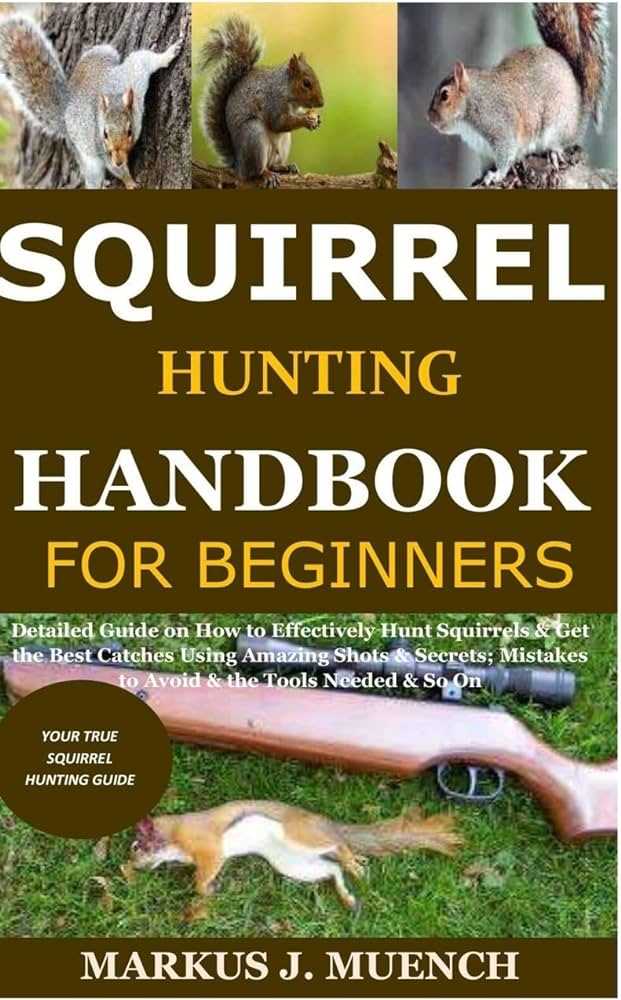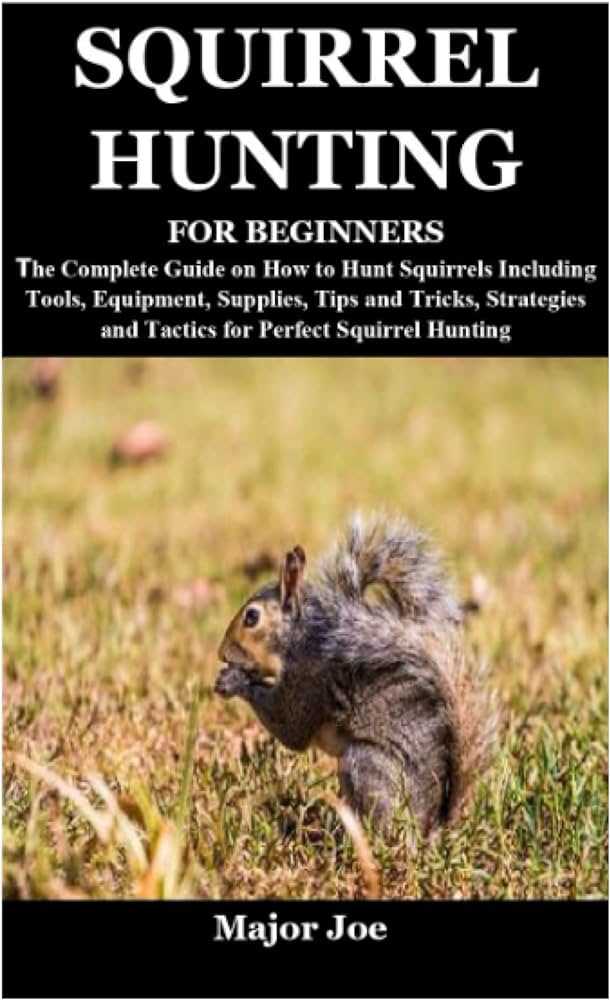Contents
Tips, Techniques, and Safety Guidelines for Hunting Squirrels

When venturing into the forest for squirrel hunting, it’s essential to be equipped with the right knowledge and skills to ensure a successful and safe experience. Squirrels are agile creatures that often scurry between trees, making it important to understand their behavior and use appropriate techniques to catch them.
One of the key strategies is to blend into your surroundings. Choose clothing that matches the forest’s color palette, allowing you to camouflage effectively. By merging with the trees and foliage, you increase your chances of approaching squirrels undetected. Remember, patience is key – being still and observing a squirrel’s path can help you plan your next move.
Following trails and signs of squirrel activity can be advantageous. Keep an eye out for scattered nuts, as they indicate the presence of these small rodents. By studying the patterns of their movements and recognizing their preferred dwelling places, such as tree hollows or nests, you can strategize the best spots for observation or hunting.
It’s crucial to note that squirrel hunting is regulated in many areas, and specific hunting seasons and bag limits may apply. Therefore, familiarize yourself with the local hunting regulations and acquire the necessary permits before embarking on your hunting expedition. Additionally, always prioritize safety by using appropriate hunting gear, including a reliable shotgun and protective gear for yourself.
In summary, squirrel hunting requires a combination of patience, skill, and knowledge. Understanding squirrel behavior, using effective camouflage, and familiarizing yourself with hunting regulations are paramount for a successful and safe hunting experience. So, gear up, grab your shotgun, and embark on a thrilling squirrel hunting adventure!
Squirrel Hunting Tips

When it comes to squirrel hunting, there are a few tips and techniques that can greatly improve your chances of success. Whether you’re hunting for food or just for sport, these tips will help you make the most out of your hunting experience.
- Know your nuts: Squirrels are known for their love of nuts, so it’s a good idea to know which types of nuts they prefer. Acorns, walnuts, and hickory nuts are some of their favorites, so keep an eye out for these types of trees in the forest.
- Choose the right weapon: While there are several different options for hunting squirrels, a shotgun is often the most effective. Make sure to choose the right shotgun and ammunition for the job, as well as familiarize yourself with local laws and regulations.
- Blend in with your surroundings: Squirrels are known for their keen eyesight, so it’s important to blend in with your surroundings. Wear camouflage clothing and consider using natural cover like trees and bushes to hide your movements.
- Use binoculars for scouting: Before you start hunting, use a pair of binoculars to scout the area. Look for signs of squirrel activity, such as chewed nuts or nests. This will help you determine the best spots to set up your hunting blind or tree stand.
Remember to always prioritize safety when squirrel hunting. Follow all local hunting regulations, use proper firearms safety techniques, and be aware of your surroundings at all times. Good luck and happy hunting!
Tips for Beginners

If you are new to squirrel hunting, there are a few tips that can help you get started on the right foot. Hunting squirrels requires a good understanding of their habits and behavior, as well as some essential equipment. Whether you are hunting in a forest or wooded area, these tips will help increase your chances of success.
1. Choose the right shotgun: When it comes to squirrel hunting, using a shotgun is the weapon of choice. A 20-gauge shotgun is recommended for beginners as it provides a good balance between power and maneuverability. Make sure to use appropriate ammunition.
2. Scout the area: Before heading out to hunt, take some time to scout the hunting area. Look for areas with plenty of trees and signs of squirrel activity such as gnawed nuts or droppings. Binoculars can be very helpful for spotting squirrels from a distance.
3. Dress for success: Squirrels have sharp eyesight and can easily spot movement. Wear clothing that blends in with the surroundings to stay hidden. Camouflage patterns that match the colors of the forest can help you stay undetected.
4. Be patient and observant: Squirrel hunting requires patience and a keen eye. Take your time and scan the area carefully for any signs of movement. Squirrels are quick and agile, so be prepared to take a shot as soon as you spot one.
5. Aim for the head: When shooting a squirrel, aim for the head to ensure a quick and humane kill. Squirrels are small and fast-moving targets, so it’s important to practice your aim and accuracy before going hunting.
6. Practice ethical hunting: Hunting is a privilege, and it’s important to practice ethical hunting principles. Follow all local hunting laws and regulations, and respect the environment and the animals you are hunting. Dispose of any waste properly and leave no trace.
Remember, squirrel hunting can be a challenging but rewarding outdoor activity. By following these tips, you will be well-prepared for your first hunting experience. Happy hunting!
Learn about different squirrel species

When it comes to squirrel hunting, it’s important to familiarize yourself with the different squirrel species that you may encounter on your hunting trips. Knowing about these different species can not only enhance your hunting experience but also help you become a more responsible hunter.
One common squirrel species that you may come across is the Eastern Gray Squirrel. This species can be found in a variety of habitats, including forests and urban areas. They are known for their bushy tails and gray fur, which helps them blend in with their surroundings. The Eastern Gray Squirrel is an agile climber and can often be seen hopping from tree to tree on the hunt for nuts.
Another squirrel species that you may encounter is the Red Squirrel. This species is typically found in coniferous forests and is known for its rusty red fur. Red Squirrels are smaller in size compared to other squirrel species and can often be heard chattering and scolding intruders. They are skilled climbers and are often seen scampering up and down trees in search of pinecones and seeds.
The Fox Squirrel is another species that you may come across while squirrel hunting. These squirrels are larger in size and are known for their reddish-brown fur and bushy tails. Fox Squirrels are often found in wooded areas and can be seen digging burrows in the ground to store their food. They are skilled jumpers and can leap from tree to tree with ease.
Lastly, the Flying Squirrel is a unique species that you may encounter. Contrary to their name, Flying Squirrels do not actually fly but glide through the air using a flap of skin called a patagium. These squirrels are nocturnal and are often found in wooded areas. They are expert gliders and can travel up to 150 feet in a single glide.
When squirrel hunting, it’s important to be able to identify these different squirrel species. This can help you ensure that you are targeting the correct species and also avoid any unintended harm to other animals. It can also enhance your overall hunting experience as you observe and appreciate the unique behaviors and characteristics of each species.
Remember to always follow proper hunting techniques, utilize appropriate safety guidelines, and respect the animals and their habitats. Be sure to bring binoculars on your hunting trips to better observe and identify different squirrel species. With the right knowledge and skills, squirrel hunting can be a rewarding and fulfilling outdoor activity.
Research hunting laws and regulations
Before going squirrel hunting, it is important to familiarize yourself with the hunting laws and regulations in your area. Each state may have different rules and restrictions when it comes to hunting squirrels.
Begin by contacting your local wildlife agency or department to obtain information on hunting licenses and any specific regulations related to squirrel hunting. They can provide you with the necessary paperwork and fees required for legal hunting.
Some common regulations you may need to be aware of include hunting seasons and bag limits. Hunting season refers to the specific time frame during which squirrel hunting is allowed, while bag limits dictate the number of squirrels you are permitted to harvest in a single outing.
Furthermore, it is crucial to understand the specific methods and weapons permitted for squirrel hunting in your region. In some areas, you may be allowed to use a shotgun, while in others, only specific types of firearms are allowed. Make sure you are knowledgeable about any restrictions on weapons and ammunition.
In addition to knowing the laws governing squirrel hunting, it is also important to understand the safety guidelines associated with this activity. Hunting in a responsible and ethical manner ensures the well-being of both the hunters and the wildlife.
Always remember to practice safe hunting techniques, such as wearing appropriate clothing for the forest environment and using camouflage to blend in with the surroundings. Binoculars and a trail camera can also be useful tools to observe squirrel behavior and track their movement.
By researching hunting laws and regulations, you can ensure that your squirrel hunting experience is both enjoyable and within the legal boundaries. Take the time to educate yourself and respect the laws put in place to protect wildlife and preserve the hunting tradition for future generations.
Practice your shooting skills

One of the most important aspects of squirrel hunting is being able to hit your target accurately. To improve your shooting skills, it is essential to practice regularly. Here are some tips to help you become a better shooter:
- Choose the right location: Find a safe and secluded spot in the forest where you can set up targets and practice shooting. Make sure there are no people or animals in the vicinity.
- Set up a target trail: Create a trail with different targets at varying distances. This will help you improve your aim and accuracy when shooting at moving targets.
- Invest in binoculars: Use binoculars to scout the area for squirrel activity. This will help you identify potential shooting spots and improve your chances of success.
- Practice shooting at nuts: Aim at small nuts or acorns hanging from tree branches. This will simulate shooting at squirrels in their natural habitat and improve your precision.
- Use a shotgun: Shotgun is the preferred firearm for squirrel hunting due to its wider spread. Practice shooting with your shotgun to get comfortable with its recoil and accuracy.
- Wear camouflage: Blend into your surroundings by wearing camouflage clothing. This will make it harder for squirrels to spot you and increase your chances of a successful hunt.
- Shoot between trees: Practice shooting at targets placed between trees to simulate the challenges of shooting in a forest. This will help you overcome obstacles and improve your shooting accuracy.
Remember, safety should always be your top priority while practicing your shooting skills. Always follow the proper safety guidelines, wear ear and eye protection, and ensure that you have a clear shooting range. Regular practice will not only enhance your shooting abilities but also make you a more confident squirrel hunter.
Tips for Advanced Hunters

Being an advanced hunter requires a higher level of skill and knowledge. Here are some tips to help you maximize your success:
- Invest in a good pair of binoculars: Binoculars will help you scout for squirrels from a distance. This can give you an advantage in detecting their presence and planning your next move.
- Learn squirrel behavior: Understanding how squirrels move, where they commonly find nuts, and how they react to threats can provide valuable insights for planning your hunting strategy. Spend time observing their behavior in the wild or gather information from experienced hunters.
- Target trees with nut-producing species: Squirrels are often found near trees that bear nuts. Look for oak, hickory, walnut, and beech trees as they are common sources of food for squirrels.
- Choose the right firearm: A shotgun is a popular choice for squirrel hunting due to its spread and effectiveness within short distances. Make sure to abide by local regulations and safety guidelines when using firearms.
- Master the art of camouflage: Squirrels have keen senses and can easily detect movement. Wear appropriate camouflage clothing and try to blend in with your surroundings to avoid being detected.
- Scout the hunting area: Familiarize yourself with the forest or hunting grounds where you plan to hunt. Look for tracks, droppings, and signs of squirrel activity to locate their feeding and nesting areas.
- Be patient and still: Squirrels are quick and agile. It’s important to remain still and patient once you have identified a target. Avoid sudden movements that might alert them.
- Practice ethical hunting: Always follow hunting regulations and respect nature. Take only what you will use and be mindful of your impact on the ecosystem.
By incorporating these tips into your squirrel hunting strategy, you can enhance your skill as an advanced hunter and increase your chances of a successful hunt.

A skilled hunter, dedicated conservationist, and advocate for ethical practices. Respected in the hunting community, he balances human activity with environmental preservation.
